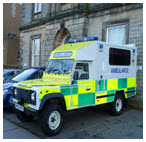New breed of paramedics charged with keeping people out of hospital
Steven Morris for The Guardian 20/01/2016, gives us a viewpoint from Steve Hulks a community paramedic practitioner in Kent, whose job is about advising, reassuring – and easing pressure on A&E
You do get a rush of adrenaline,” says Steve Hulks as he activates the blue lights and siren and speeds to the first 999 call of his shift – an elderly man has fallen in his bedroom and is unable to get back on to his feet.
“But you have to be careful that the rush doesn’t distract you. You need to drive safely and think of what you need to do when you get there – how to get in, where the key may be hidden, what you may need, what may have happened to the patient. You have to stay calm.”
Hulks is one of a new breed of ambulance personnel. When he first signed up a quarter of a century ago the job entailed going to the scene of an emergency and rushing the patient to hospital. “It was about doing some first aid, putting the patient in the back of an ambulance and taking them to A&E. The problem is most people didn’t need to be in hospital – it was no good for them and no good for the hospital.”
Now as a community paramedic practitioner working on a ground-breaking scheme in the seaside town of Whitstable, Kent, the aim is just about the opposite.
He is still there to save lives but his job now is much more about helping an ageing population stay out of hospital and remain independent, advising and reassuring troubled young people, thinking about patients’ mental wellbeing as well as their physical health and working closely with GPs and other primary care providers to create a more joined-up service.
The door of 90-year-old Jack’s flat is open when Hulks arrives. Jack just about missed bashing his head on a chest of drawers when he tumbled. Carefully, Hulks checks him over before using an inflatable cushion to get him back into his wheelchair. “That’s better, that’s heaven,” Jack tells Hulks. “I don’t want to end up in hospital – that would be terrible for me. I like it here, I like my garden.”
Over the next hour (there is no set limit to the time he spends with patients) Hulks carries out a series of tests on Jack, from his blood pressure to his eyesight. The elderly man appears confused, which could trigger a trip to hospital for head injury tests. But Hulks has visited Jack several times before and so knows he suffers from short-term memory loss. He is happy to leave him sitting in his wheelchair looking out on to his garden, knowing that a carer will arrive soon to give him lunch.
It is a good example of how the scheme works. The idea is to embed teams of highly trained paramedic practitioners into the heart of communities. They have the decision-making skills – plus the local knowledge of regular patients – to know when someone needs to be taken to hospital and when they are better off staying where they are.
Launched in Whitstable last spring and now being rolled out across other areas in Kent, the scheme has already kept scores of people out of hospital. Only a third of 999 calls handled by Hulks and his colleagues have ended in someone going to hospital; across the South East Coast ambulance service’s whole patch, the figure is around 50% – and in some trusts it is up to 70% or 80%. It is good news for patients and good for hospital emergency departments – crucial at this time of year. Other trusts across the country are watching with interest.
Today Hulks, 57, is staffing a 999 car, ready to head to urgent calls like Jack’s fall. His colleague Jess Willetts is in the GP car, carrying out home visits on behalf of the doctors’ surgery where they are based. This helps take the pressure off the hard-pressed GPs – they may be able complete six appointments at the surgery while Willetts does one home visit – and also tethers the paramedic practitioners to the patch they are covering. Meanwhile, other more conventional ambulance crews are ready to head for emergencies more likely to require hospital transfers.
Hulks’ second job of the shift is a reported assault. A young woman has been kicked in the back and had her head slammed against the steering wheel of her car, apparently by her partner. The police head off in search of the attacker while Hulks checks her over. Like Jack, she would have been taken straight to hospital a few years ago but Hulks satisfies himself that she does not need to go to A&E.
It not just her physical state Hulks considers. He talks to her about her fears and concerns. He tells her that social services may be involved. “She was upset, shaken. It’s good to give people a chance to talk. It’s often as much about mental health as physical health. We try to provide more of a holistic service.”
Another vulnerable elderly man, Pete, is the next patient to be visited, this time by Hulks and Willetts together. The 83-year-old fainted face-first into his smoked haddock at lunchtime and needs an ECG to test his heart. It saves him having to be taken to the GP surgery – good for the surgery, good for the patient.
Pete is not happy to see the paramedics. “What’s all this about? I’m fine,” he mutters. Hulks and Willetts chivvy him along. “You do the job to help people, to make a difference,” says Hulks later, “You’re journeying with someone through illness or crisis. You’re there for that moment helping, supporting.”
“Nowadays, the safest ‘pair of hands’ you can be in is most probably a paramedics – strength to all of them”




